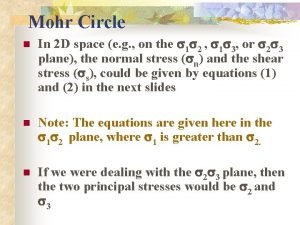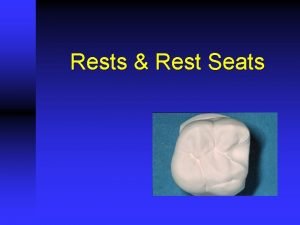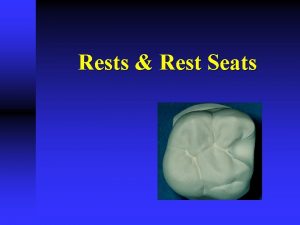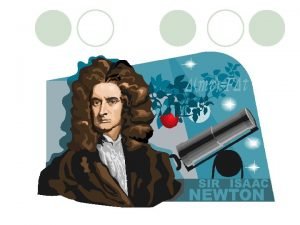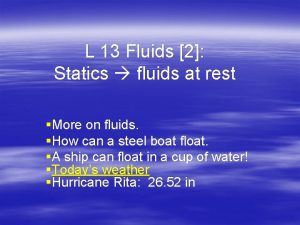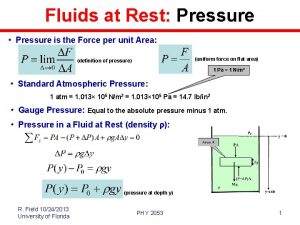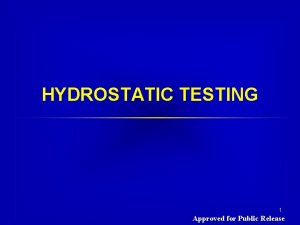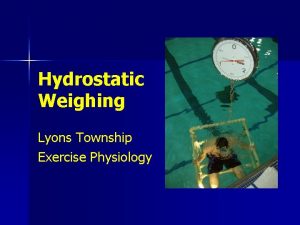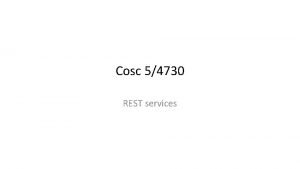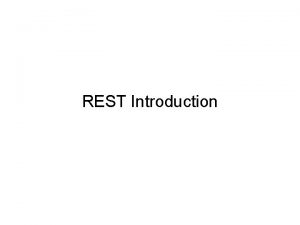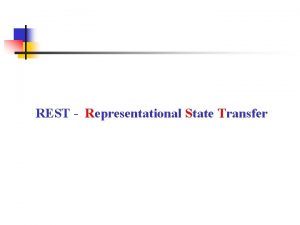FLUID AT REST Hydrostatic condition when a fluid













- Slides: 13

FLUID AT REST � Hydrostatic condition: when a fluid velocity is zero, the pressure variation is due only to the weight of the fluid. • There is no pressure change in the horizontal direction. • There is a pressure change in the vertical direction proportional to the density, gravity, and depth change. • In the limit when the wedge shrinks to a point,

PRESSURE FORCES (PRESSURE GRADIENT) � • • Assume the pressure vary arbitrarily in a fluid, p=p(x, y, z, t). The pressure gradient is a surface force that acts on the sides of the element. Note that the pressure gradient (not pressure) causes a net force that must be balanced by gravity or acceleration.

EQUILIBRIUM � The pressure gradient must be balanced by gravity force, or weight of the element, for a fluid at rest. • The gravity force is a body force, acting on the entire mass of the element. Magnetic force is another example of body force.

GAGE PRESSURE AND VACUUM � The actual pressure at a given position is called the absolute pressure, and it is measured relative to absolute vacuum. P Pgage Pabs Pvac Patm Absolute (vacuum) = 0

HYDROSTATIC PRESSURE DISTRIBUTION � For a fluid at rest, pressure gradient must be balanced by the gravity force • Recall: ∇p is perpendicular everywhere to surface of constant pressure p. • In our customary coordinate z is “upward” and the gravity vector is: where g = 9. 807 m/s 2. The pressure gradient vector becomes:

HYDROSTATIC PRESSURE DISTRIBUTION � � Pressure in a continuously distributed uniform static fluid varies only with vertical distance and is independent of the shape of the container. The pressure is the same at all points on a given horizontal plane in a fluid. • For liquids, which are incompressible, we have: • The quantity, p⁄γ is a length called the pressure head of the fluid.

THE MERCURY BAROMETER Patm = 761 mm. Hg � Mercury has an extremely small vapor pressure at room temperature (almost vacuum), thus p 1 = 0. One can write:

HYDROSTATIC PRESSURE IN GASES � Gases are compressible, using the ideal gas equation of state, p=ρRT: • For small variations in elevation, “isothermal atmosphere” can be assumed: • In general (for higher altitudes) the atmospheric temperature drops off linearly with z T≈T 0 - Bz where T 0 is the sea-level temperature (in Kelvin) and B=0. 00650 K/m. • Note that the Patm is nearly zero (vacuum condition) at z = 30 km.

MANOMETER � A static column of one or multiple fluids can be used to measure pressure difference between 2 points. Such a device is called manometer. • Adding/ subtracting γ∆z as moving down/up in a fluid column. • Jumping across U-tubes: any two points at the same elevation in a continuous mass of the same static fluid will be at the same pressure.

HYDROSTATIC FORCES ON SURFACES � Consider a plane panel of arbitrary shape completely submerged in a liquid. • The total hydrostatic force on one side of the plane is given by:

HYDROSTATIC FORCES ON SURFACES � After integration and simplifications, we find: • The force on one side of any plane submerged surface in a uniform fluid equals the pressure at the plate centroid times the plate area, independent of the shape of the plate or angle θ. • The resultant force acts not through the centroid but below it toward the high pressure side. Its line of action passes through the centre of pressure CP of the plate (x. CP, y. CP).

HYDROSTATIC FORCES ON SURFACES � Centroidal moments of inertia for various cross-sections. • Note: for symmetrical plates, Ixy = 0 and thus x. CP = 0. As a result, the center of pressure lies directly below the centroid on the y axis.

HYDROSTATIC FORCES: CURVED SURFACES � The easiest way to calculate the pressure forces on a curved surface is to compute the horizontal and vertical forces separately. • The horizontal force equals the force on the plane area formed by the projection of the curved surface onto a vertical plane normal to the component. • The vertical component equals to the weight of the entire column of fluid, both liquid and atmospheric above the curved surface. FV = W 2 + W 1 + Wair
 Fluid statics deals with
Fluid statics deals with Fluid statics deals with fluid at rest
Fluid statics deals with fluid at rest Interstitial fluid hydrostatic pressure
Interstitial fluid hydrostatic pressure Oncotic pressure
Oncotic pressure Hydrostatic stress mohr's circle
Hydrostatic stress mohr's circle Engineering drawing symbols and meanings
Engineering drawing symbols and meanings Rest rest perturbed spirit
Rest rest perturbed spirit Shape of occlusal rest
Shape of occlusal rest Incisal rest seat
Incisal rest seat Object at rest stays at rest
Object at rest stays at rest Tellmark uri
Tellmark uri Fluids at rest
Fluids at rest For a fluid at rest
For a fluid at rest Timeline fluid mechanics
Timeline fluid mechanics




